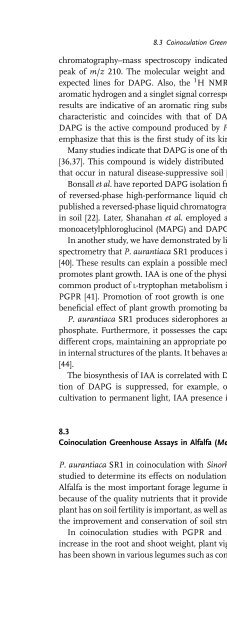Page 2 Plant-Bacteria Interactions Edited by Iqbal Ahmad, John ...
Page 2 Plant-Bacteria Interactions Edited by Iqbal Ahmad, John ...
Page 2 Plant-Bacteria Interactions Edited by Iqbal Ahmad, John ...
Create successful ePaper yourself
Turn your PDF publications into a flip-book with our unique Google optimized e-Paper software.
8.3 Coinoculation Greenhouse Assays in Alfalfa (Medicago sativa L.)j157<br />
chromatography–mass spectroscopy indicated the presence of an ion molecular<br />
peak of m/z 210. The molecular weight and fragmentation pattern were on the<br />
expected lines for DAPG. Also, the 1 H NMR spectrum showed the presence of<br />
aromatic hydrogen and a singlet signal corresponding to aliphatic hydrogens. These<br />
results are indicative of an aromatic ring substituted <strong>by</strong> an acetyl group, which is<br />
characteristic and coincides with that of DAPG. The identification reveals that<br />
DAPG is the active compound produced <strong>by</strong> P. aurantiaca SR1. It is important to<br />
emphasize that this is the first study of its kind on this bacterium in Argentina.<br />
Many studies indicate that DAPG is one of the most important isolated antibiotics<br />
[36,37]. This compound is widely distributed in antagonistic P. fluorescens strains<br />
that occur in natural disease-suppressive soil [38].<br />
Bonsall et al. have reported DAPG isolation from soil and broth cultures <strong>by</strong> means<br />
of reversed-phase high-performance liquid chromatography [20]. Shanahan et al.<br />
published a reversed-phase liquid chromatographic analysis of DAPG in culture and<br />
in soil [22]. Later, Shanahan et al. employed a gradient LC assay for determining<br />
monoacetylphloroglucinol (MAPG) and DAPG in growth culture media [39].<br />
In another study, we have demonstrated <strong>by</strong> liquid chromatography–tandem mass<br />
spectrometry that P. aurantiaca SR1 produces indol-3-acetic acid (IAA) (11 mgml 1 )<br />
[40]. These results can explain a possible mechanism for which P. aurantiaca SR1<br />
promotes plant growth. IAA is one of the physiologically most active auxins and is a<br />
common product of L-tryptophan metabolism in several microorganisms including<br />
PGPR [41]. Promotion of root growth is one of the major markers <strong>by</strong> which the<br />
beneficial effect of plant growth promoting bacteria is measured [5,42,43].<br />
P. aurantiaca SR1 produces siderophores and HCN and moderately solubilizes<br />
phosphate. Furthermore, it possesses the capacity to colonize the root systems of<br />
different crops, maintaining an appropriate population in the rhizosphere area and<br />
in internal structures of the plants. It behaves as an endophyte in wheat and soybean<br />
[44].<br />
The biosynthesis of IAA is correlated with DAPG production. When the production<br />
of DAPG is suppressed, for example, owing to exposition of the bacterial<br />
cultivation to permanent light, IAA presence is not detected.<br />
8.3<br />
Coinoculation Greenhouse Assays in Alfalfa (Medicago sativa L.)<br />
P. aurantiaca SR1 in coinoculation with Sinorhizobium meliloti strain 3DOh13 was<br />
studied to determine its effects on nodulation and growth of alfalfa (M. sativa L.).<br />
Alfalfa is the most important forage legume in the semiarid Argentinean Pampas<br />
because of the quality nutrients that it provides [45]. Therefore, the effect that this<br />
plant has on soil fertility is important, as well as the contribution of its root system to<br />
the improvement and conservation of soil structure [46].<br />
In coinoculation studies with PGPR and Rhizobium/Bradyrhizobium spp., an<br />
increase in the root and shoot weight, plant vigor, nitrogen fixation and grain yield<br />
has been shown in various legumes such as common bean [47], green gram [48], pea
















